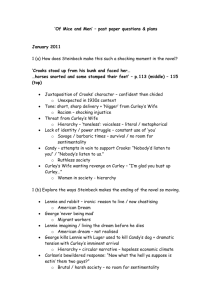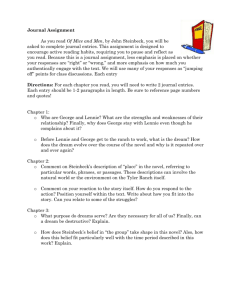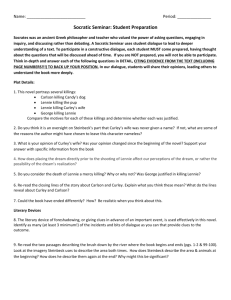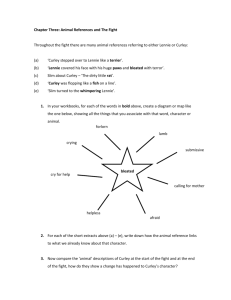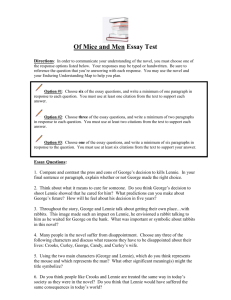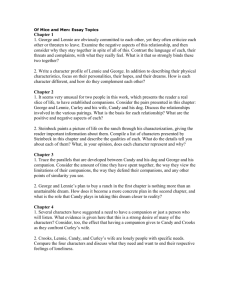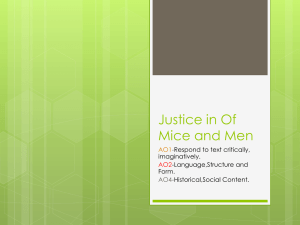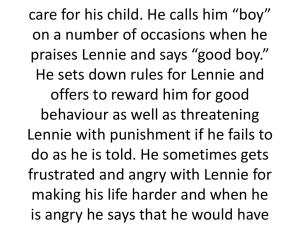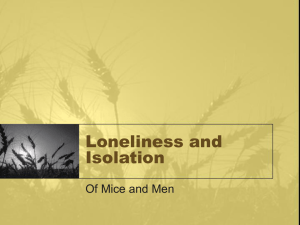Chapter 1 - Barrington 220
advertisement
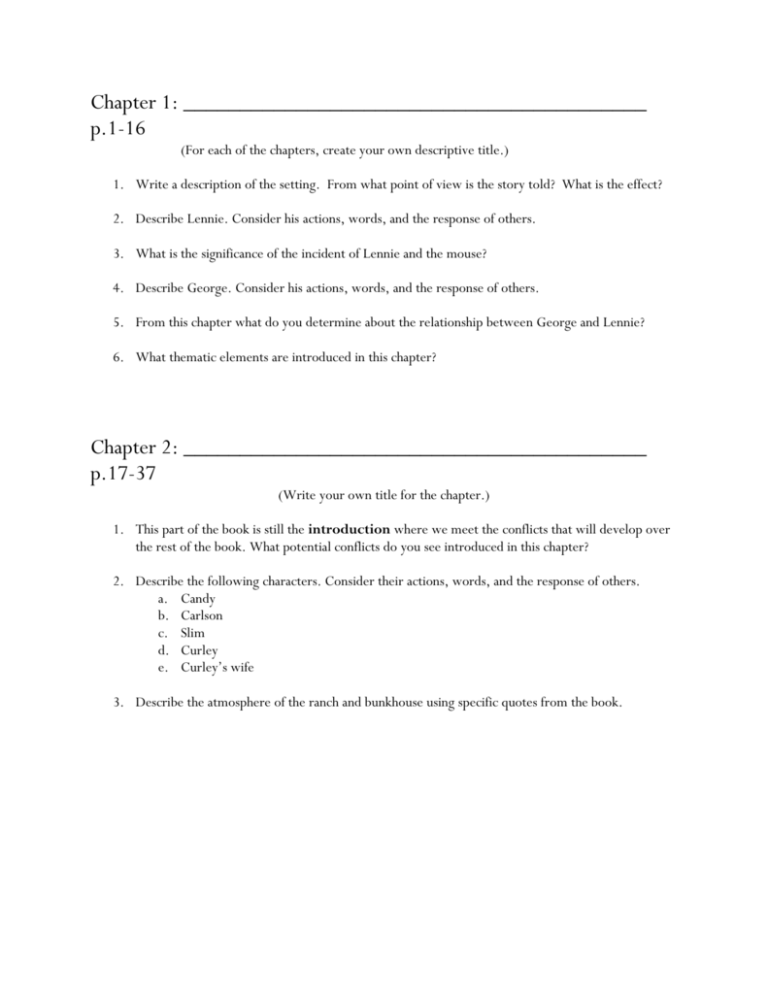
Chapter 1: _________________________________________ p.1-16 (For each of the chapters, create your own descriptive title.) 1. Write a description of the setting. From what point of view is the story told? What is the effect? 2. Describe Lennie. Consider his actions, words, and the response of others. 3. What is the significance of the incident of Lennie and the mouse? 4. Describe George. Consider his actions, words, and the response of others. 5. From this chapter what do you determine about the relationship between George and Lennie? 6. What thematic elements are introduced in this chapter? Chapter 2: _________________________________________ p.17-37 (Write your own title for the chapter.) 1. This part of the book is still the introduction where we meet the conflicts that will develop over the rest of the book. What potential conflicts do you see introduced in this chapter? 2. Describe the following characters. Consider their actions, words, and the response of others. a. Candy b. Carlson c. Slim d. Curley e. Curley’s wife 3. Describe the atmosphere of the ranch and bunkhouse using specific quotes from the book. Chapter 3: _________________________________________ p.38-65 (Write your own title for the chapter.) 1. Why did George and Lennie have to flee Weed? 2. What is the dream? How much does it cost? Who will chip in on the dream? How much will he chip in? 3. What does the situation with Candy's dog tell the reader about each of the men involved? 4. Candy says, “I ought to of shot that dog myself, George. I shouldn’t ought to of let no stranger shoot my dog.” Why does he say this? Why does he think that he should have shot his dog? 5. What is the significance of the altercation between Lenny and Curley? 6. Trace the development of the following symbols/themes thus far in the novel: hands; loneliness; dreams. Chapter 4: _________________________________________ p.66-83 (Write your own title for the chapter.) Thoughtfully answer the following questions. 1. Describe Crooks. 2. Why does Crooks suggest to Lennie that George may never come back? Before answering, consider Crooks’ relationship to the other men, the location of his home, and the narrator’s comments on the bottom half of page. 71. 3. In their encounter with Curley’s Wife, do the men have any power? Explain. (81) 4. Why does Crooks say that he doesn’t really want to be part of their dream farm? (83) 5. List the people we meet in the chapter. Why are they around the farm this night? What does this tell us about them? 6. How is the theme of loneliness developed in this chapter? Think about the characters Lennie, Crooks, Candy, and Curley's wife. Chapter 5: _________________________________________ p. 84-98 (Write your own title for the chapter.) Thoughtfully answer the following questions. 1. Why is Curley’s Wife called Curley’s wife? What does the name imply about her character? 2. Can we trust the description of her offered by the other men? How/Why might their descriptions be inaccurate? 3. What is Curley’s wife’s dream? How close did she come to attaining it? 4. How does Curley’s wife’s revelation about her dream and her relationship to Curley explain her actions on the farm? What does she long for? 5. In what ways is Curley’s wife like the other men on the farm? 6. Why is the interaction between Curley's wife and Lennie possible? In other words, what elements does Steinbeck set in motion (characters and their interactions, setting, timing, etc.) that makes the conflict reasonable and believable? 7. Why does Lennie react to Curley's wife as he does? There are a number of variables that bring about his actions. 8. How does George react to Candy's news about Lennie? What does this tell us about George? Chapter 6: _______________________________________ p. 99-107 (Write your own title for the chapter.) Thoughtfully answer the following questions. 1. Read the first two pages of the last chapter and then go back and read the first two pages of the last chapter. How are they similar? different? 2. Why does Lennie talk to Aunt Clara and the rabbit? 3. Up to this point Lennie has not hallucinated. How does Lennie’s talking to Aunt Clara and the rabbit change our understanding of Lennie? Does this change make it easier or harder for us to accept George’s final actions? Why does Steinbeck conclude the novel with Carlson’s word: “Now what the hell ya suppose is eatin’ them two guys?” (107)? What might his words suggest about life endured by Lennie, George and the others? 4. Was George justified in his final actions?
